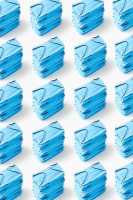
13 Mar Masks: How May Layers Offer Best Protection Against Cough Droplets?
MedicalResearch.com Interview with:

Dr. Saha
Abhishek Saha, PhD
Assistant Professor
Department of Mechanical and Aerospace Engineering
University of California San Diego
MedicalResearch.com: What is the background for this study?
Response: At a very early stage of COVID 19 pandemic, the scientific community identified that respiratory droplet is the primary mode of transmission of the SARS-CoV2 virus. Naturally, the health agencies have encouraged facemasks to restrict these droplets from spreading during respiratory events, like coughing, sneezing, talking, etc. While WHO recommended using either N95 masks or other types of three-layer masks, due to a sharp increase in demand and scarcity in supplies, a variety of either home-made or locally purchased masks became popular. Naturally, one wonders if these single- and double-layer masks provide enough protection. To provide some insight into this critical question, our team, which also includes Professor Swetaprovo Chaudhuri from the University of Toronto, and Professor Saptarshi Basu of the Indian Institute of Science, experimentally analyzed what happens to the respiratory droplets when they impact single- and multi-layer masks.
 MedicalResearch.com: What are the main findings?
MedicalResearch.com: What are the main findings?
Response: We focused our study [1] on large (larger than 200 micron) respiratory droplets, which are supposed to settle quickly on ground during respiratory events due to their excess weight. It is also important to note, despite being very few in numbers, these larger droplets contain more than 80% of the liquid volume that we expel during common respiratory events.
We observed that 3-layer surgical masks block these large respiratory droplets generated during cough entirely. However, single- and double-layer masks only partially block these droplets as they penetrate the mask-layers and produce numerous smaller droplets/aerosols. These smaller 50-80 micron-sized droplets coming through the first and second layer of a mask will linger in the air, where they can spread to people at larger distances.
Naturally, the study shows three-layer masks provide better protection. While this advice was initially based on the fact that they are more effective in preventing small particles from passing through the mask pores, this study has shown that three-layered masks are also most effective at stopping large cough droplets from getting atomized into smaller droplets/aerosols.
MedicalResearch.com: What should readers take away from your report?
Response: Everyone should use masks following the local health guidelines. N95 masks are most effective. When N95 masks are not available, one should use three-layer masks. However, it should be noted that, despite providing only partial protection, single and double-layer masks are far better than no-mask situations.
MedicalResearch.com: What recommendations do you have for future research as a result of this work?
Response: While the current study demonstrates the possibility of penetration and atomization of cough droplets through single- and double-layer surgical masks, an extensive investigation with other mask materials, and other respiratory events such as sneezing, talking, etc. warrants exploration.
References:
[1] S Sharma, R Pinto, A Saha, S Chaudhuri, S Basu, On secondary atomization and blockage of surrogate cough droplets in single-and multilayer face masks, Science Advances 7 (10), eabf0452, 2021
[2] S Basu, P Kabi, S Chaudhuri, A Saha, Insights on drying and precipitation dynamics of respiratory droplets in the perspective of Covid-19, Physics of Fluids 32 (12), 123317, 2020
[3] S Chaudhuri, S Basu, P Kabi, VR Unni, A Saha, Modeling the role of respiratory droplets in Covid-19 type pandemics, Physics of Fluids 32 (6), 063309, 2020
[4] S Chaudhuri, S Basu, A Saha, Analyzing the dominant SARS-CoV-2 transmission routes toward an ab initio disease spread model, Physics of Fluids 32 (12), 123306, 2020
Citation:
On secondary atomization and blockage of surrogate cough droplets in single- and multilayer face masks
BY SHUBHAM SHARMA, ROVEN PINTO, ABHISHEK SAHA, SWETAPROVO CHAUDHURI, SAPTARSHI BASU
SCIENCE ADVANCES05 MAR 2021 : EABF0452
[subscribe]
[last-modified]
The information on MedicalResearch.com is provided for educational purposes only, and is in no way intended to diagnose, cure, or treat any medical or other condition. Always seek the advice of your physician or other qualified health and ask your doctor any questions you may have regarding a medical condition. In addition to all other limitations and disclaimers in this agreement, service provider and its third party providers disclaim any liability or loss in connection with the content provided on this website.
Last Updated on March 13, 2021 by Marie Benz MD FAAD
